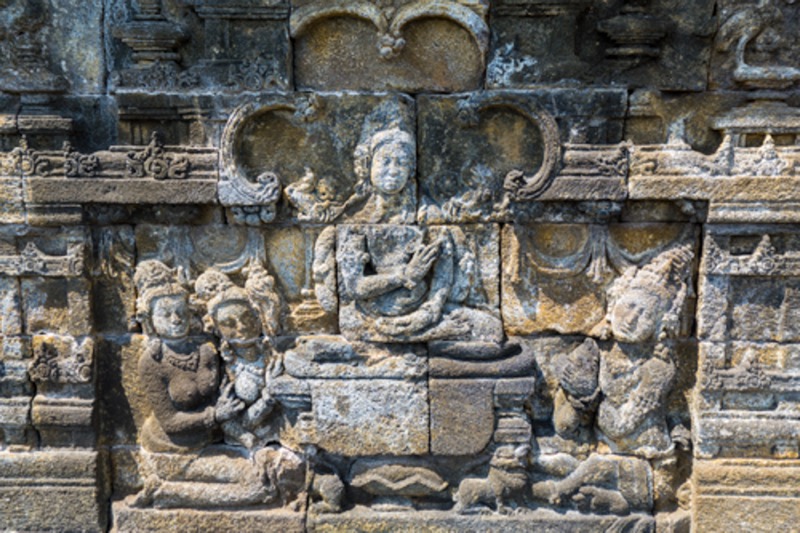In order to lead sentient beings from suffering and dissatisfaction to temporal and ultimate happiness, Lord Shakyamuni Buddha turned the wheel of Dharma, imparting various teachings to suit the mental dispositions of disciples at different levels. He taught at different places, at different times and in different languages. Lord Buddha's teachings were later collected into the Tripitaka, or three baskets: the Vinaya, Sutra and Abhidharma. Later on, various highly realised masters and great Indian Panditas wrote extensive commentaries on these teachings. For hundreds of years the teachings of the Lord Buddha spread through many countries with great success.
In the 4th century AD during the reign of Dharma King Lha-Tho-Tho Ri-Nyen Tsen, the Buddhadharma was introduced to the Land of Snows. Five generations later, King Songtsen Gampo formally established Buddhism as the official religion of Tibet. Five generations later Dharma King Trison Detsen invited the Bodhisattva Shantarakshita and the renowned Guru Padmasambhava to consolidate the vast teachings of the Sutras, Tantras and Shastras in Tibet. These teachings are still preserved by the great masters of Tibetan Buddhism.


Ngorchen Kunga Zangpo
The lineage of the Khön family can be traced back for thousands of years. The ancestors of the family were heavenly beings who descended directly from the heavenly realms. After a few generations, one of the Khön family members known as Yapang Kye subdued the Rakshas and subsequently the family received the name "Khön". Several generations later in 1073, a member of the Khön family and renowned master called Khön Konchok Gyalpo established the glorious Sakya School, one of the four schools of Tibetan Buddhism. Since that time successive generations of the Khön family have continued in an unbroken lineage. Many famous and great masters have appeared in this illustrious Khön lineage, including the five great founders of the Sakyapa Order: the Great Sachen Kunga Nyingpo (1092-1158), Loppon Rinpoche Sonam Tsemo (1142-1182), Jetsun Rinpoche Dragpa Gyaltsen (1147-1216), Chojé Sakya Pandita (1182-1251) and Drogon Chogyal Phagpa (1235-1280).
These masters were all emanations of Arya Manjushri (the manifestation of all the Buddhas' wisdom), Avalokiteshvara (the manifestation of all the Buddhas' compassion) and Vajrapani (the manifestation of all the Buddhas' power).
Amongst the principal holders of the Sakya tradition are the five great founders of the Sakyapa Order, who are known as the Five Patriarchs of the Sakya Tradition. After them were the Six Ornaments of Tibet: Yaktuk Sangyey Pal and Rongton Mawe Sengey, who were reputed for their authority on sutra teachings, Ngorchen Kunga Zangpo. Ngor Monastery was founded in 1429 by the great master Ngorchen Kunga Zangpo (1382-1450). Prophesised by the Buddha, he was a brilliant scholar, teacher and Vajramaster (read more) and Zongpa Kunga Namgyel, who were learned in the tantras, and Goram Sonam Sengey and Shakya Chogden who were learned in both sutras and tantras. These are the famous spiritual masters of the Sakya tradition.
Like other traditions of Tibetan Buddhism, a number of sub-divisions emerged within the main Sakya tradition. The Ngor lineage of teachings within the discipline were instituted by Ngorchen Kunga Zangpo (1382-1450) and successive masters from Konchok Lhundrup right up to the current day 77th Abbot of Ngor Lineage (see Ngor Lineage). The Sakya school of the Khön lineage represents the main trunk of the tree, of which the Ngorpa and Tsarpa are branches. These are the three schools (Sa-Ngor-Tsar-gsum) in the Sakya tradition.
In general, Tibetan Buddhism teaches that we are all potential Buddhas because we are essentially pure and luminous at the most basic level of existence. This purity, called Buddha-nature, is typically clouded over by a dense layer of ignorance and negativity, which dominates us and leads to suffering. The Tibetan Buddhist path encourages its practitioners to adopt the traits and characteristics of enlightened beings through the use of special meditational techniques, thereby realising their innate Buddha-nature.